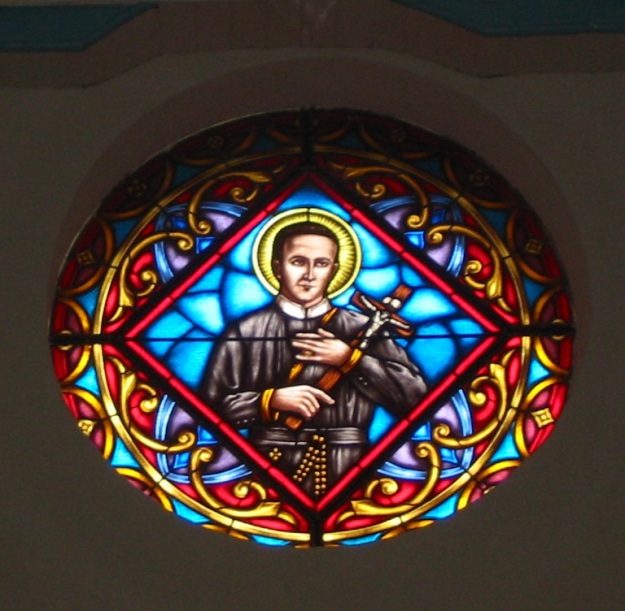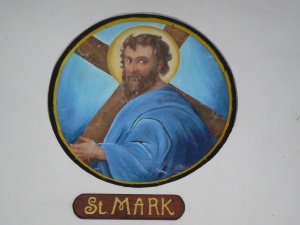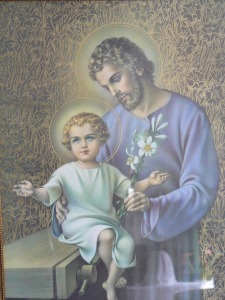 St. Joseph church’s stained glass depicting St. Gerard Majella, Redemptorist. Each year the feast of St. Gerard is celebrated in St. Joseph
St. Joseph church’s stained glass depicting St. Gerard Majella, Redemptorist. Each year the feast of St. Gerard is celebrated in St. Joseph
There was a Catholic church in the village of St. Joseph as early as 1740,
and a resident priest from February 16th, 1752.
On that date Father Lamaisonneuve, Cordelier or Franciscan Friar, who had arrived in Dominica from Martinique in 1749 and been stationed two years at Grandbay as parish priest, was transferred to St. Joseph. From the end of 1759 all the baptisms of St Joseph and neighboring hamlets were administered and all marriages blessed in Roseau. In an act of 1773, preserved in Roseau, it is expressly stated that there was no resident priest at St Joseph. The parish was not reorganized till 1825.

mural in St. Joseph church
A scrap of a document signed by William Nicolay, Governor of Dominica, states that on the 24th of July, 1825, the people of the parish of St. Joseph had assembled after High Mass, at the sound of the church bell, in the house of Mr. Jean Baptiste Riviere, to deliberate on the election and nomination of a parish priest and a church warden. This was an old French custom which had survived from the time of the French occupation. They unanimously and with the approval of His Excellency William Nicolay and the Ordinary of the said island of Dominica, nominated the Rev. Father Philip Ximeno parish priest, and Mr. J.B. Riviere church warden of the parish of St. Joseph. According to the document drawn on this occasion father Philip Ximeno was officially appointed the first parish priest of St Joseph.
At that time, the church was situated on the north bank of the St Joseph’s river, on the grounds of Mr. J.B.Riviere. It consisted of walls: “plastered with mud “, a roof “thatched with straw” and flooring “with boards”. (According to the ECCLESIASTICAL BULLETIN OF ROSEAU). Padre Philip Ximeno, a Spanish priest, remained in charge of St. Joseph till 1828.
In 1828, on May 25th, Fr. Philip Ximeno succeeded his uncle Jean de la Hoz Ximeno as parish priest of Roseau. His tenure only lasted a few months as Fr. Francois Morin was officially appointed Parish Priest of Roseau by the Apostolic Vicar Daniel McDonnell in 1829. He visited St. Joseph off and on, but there was no resident priest in St. Joseph during that period.
From 1834, there appears in the parish records the name of Fr. De Lort, who signs “Curé”, although he was parish priest of Colihaut only, and not of St. Joseph. Yet, he built a new church at St. Joseph, a cruciform building in stone, and blessed it, together with a church bell, on July 9th, 1846. The church was to a great extent was built by the generosity of Mr. J B Riviere, who departed this life before the completion of the church.

notice the geometric motives painted on the ceiling of the St. Joseph church. photograph from 1990
From 1847 till 1852 there was a resident priest in St. Joseph named Father Sallon. He was succeeded by Father Zannetlini, who was officially appointed and solemnly installed on the 24th of February 1853 by Vicar General Edward Patrick Smith.
Father Zannetlini recorded that : “The parish has no presbytery and no furniture. The church is thoroughly neglected; there are no doors and no locks. The church furniture consists of one monstrance, one ciborium, one censer and four chasubles, a single one of which is not worn out. There is only one alb , and no funds whatsoever available.” Four months later he resigned his office and soon left the island.
In June 1853, Father Boué took possession of the parish with full authority vested in him by Monsignor Edward Smith, Vicar Apostolic of Port-of-Spain. He remained parish priest up till 1855. By that time, Dominica had become a Diocese with a Bishop based in Roseau. Father Boué did not stay long either as Fr. Bompart took his place in June 1855, but left less than 3 years after.
Bishop Poirier wrote about him: “Father J. F. Bompart, of the Diocese of Valence, France, left the island to return to his native country after four years spent as parish priest at St Joseph. He was a very zealous and pious priest, but over-anxious about temporal things, so much so that he neglected the house of God, which he left in a rather pitiable state. His shattered health and infirmities, brought about by old age, are the sole cause of his departure.”

St. Joseph church in 1989
Many people may not remember that St. Joseph was known as “a fever hole” and that several missionaries sacrificed their health and lives in an effort to bring the word of God there.
And so it was with Fr. Jean August Vabret, of the Eudist Order from France, who became parish priest in St. Joseph at the end of 1859 and was dead by September 1860. Needless to say that the construction works on the church in St. Joseph did not progress at all.
For two years the parish remained without a pastor, and had to be attended to from Roseau and Mahaut. In the middle of 1862, Father Jacques Philippe Lacot, of the Eudist Order, arrived from France and was at once appointed parish priest. His missionary career in Dominica was as short as his predecessor’s: after a lingering illness he died of congestion of the lungs in October 1863. He was buried in the church of St. Joseph.
For a time the district was served again by a priest out of Roseau, Mahaut, Colihaut or Portsmouth. In January 1872, Father Lorgeau was appointed parish priest of St. Joseph.
Father Lorgeau was born in France and had been for ten years a missionary in Guadeloupe. Afterwards he became parish priest of Capesterre, in Marie Galante, where he soon got into hot water. Driven from his parish by political factions, he embarked during the night on a small rowing boat and was brought to Dominica by some faithful friends. He came however with excellent testimonials and Bishop Poirier accepted the fugitive priest with open arms and appointed him first parish priest of Mahaut and next in 1872 of St. Joseph.
Soon after his arrival in his new parish, he determined on enlarging the small St. Joseph church, which have become altogether insufficient to accommodate the ever-increasing population in 1874. The façade, built in 1846, was pulled down; pillars and arches were built inside the old church and the two side-chapels extended. In March 1875 the Bishop went to St. Joseph in order to close the ceremonies held in honour of St. Joseph, and to bless a new statue of the Patron Saint of the parish.
Broken in health, Fr. Lorgeau kept working hard till 1879, when the parish had to be attended to again by parish priests of Mahaut and Colihaut. Neither the one nor the other, however, was able to continue the building.
It is not until the middle of 1881 that a new parish priest for St. Joseph became available, in the person of Fr. Louis N. Martineau, a native of Martinique, ordained in Roseau in 1875, and since then parish priest of Portsmouth, Dominica.
Energetic and enterprising, he was determined on completing the church by building the façade and completing the two wings. The first stone of the façade was solemnly blessed on November 20, 1884 by Bishop Michael Naughten [1880-1900], successor of Bishop Poirier.
The collection taken up on this occasion towards the new building was disappointing; and so it is not surprising that on January25, 1887, the Bishop visited the parish for confirmation and “ severely upbraided the congregation for their indifference and neglect with regard to the finishing of their church, now so long in that unfinished state, more than seven years before he came to Dominica as Bishop”.
The church was still far from completion when Father Martineau departed this life in October 1889 after a long and painful illness. The parish was once more without a pastor. 
one of the many MURALS in St. Joseph church, depicting the apostles
In June 1891 Fr. Theodore Gerbier FMI was put at the head of the parish for four years. He was determined to work “not only to the spiritual welfare of his flock” but also to the completion of the parish church. He finished the front of the church and the side aisles. He also put new galvanized roof sheets on the whole church and imported a “fine high altar made of steel”.
Redemptorist Fr. Alfred Stainforth was appointed parish priest in 1916. His first concern was the beautification of the church to make it a worthy place for God and Catholic liturgies: he installed a stone floor in the church, built a new set of pews and put up a communion rail. A few years later, he built a side chapel with a large baptistery underneath, and erected the beautiful tower, “which will remain for generations the pride of the parishioners of St Joseph”[according to THE ECCLESIASTICAL BULLETIN OF ROSEAU (EBR) ].
The hurricane of September 1, 1930 damaged the St. Joseph church roof badly. Bishop James Moris reported that “thousands are without shelter, their houses having been reduced to a heap of ruins. All provision gardens have been swept clean by the onslaught of the elements. Nearly all lime trees, cacao trees, coconut trees, banana and others lay broken or uprooted, to die in the blazing September sun. Unless people begin seriously to plant provisions, and yet again provisions, and that without the least delay, famine may be at our doors before weeks”.
We are not sure if Father Felix Boghaert, another Belgian Redemptorist, was appointed parish priest before or after the destruction caused by this hurricane in 1930. In any case, he started to enlarge the parish church as the church attendance and population of St. Joseph was growing . It is a familiar phenomenon that people are driven back to church and God after a disaster, and this might have been a contributing factor to the need to enlarge the church building . Fr. Felix also built the present presbytery adjacent to the church.

renovation works on the St. Joseph church in 2000
I want to briefly mention Fr. Valère Vanackere C.Ss.R, who was appointed parish priest of St. Joseph on the 23th November 1963. He was deeply loved by the people. He carried out repair works on the church by breaking down the spire of the tower and replaced it with concrete. He also got the façade of the church plastered.
It was during his time that in response to the decisions made at the Second Vatican Council, the interior of the church was drastically changed : the old altar as well as the steel High Altar were broken down and refashioned so that the priest would face the congregation during Mass.
Fr. Paul Loncke C.Ss.R replaced Fr. Vanackere for a short spell of 7 months. During that period history was made, as for the first time, a woman read the epistle at Holy Mass, something which was not allowed before. He name was Mrs. Hilda Bruno.
We now move to recent times : Fr. Rodney Olive C.Ss.R can be credited with the construction of the beautiful arch at the church grounds’ entrance and the construction of the cemetery walls.
In 1988 Fr. Glanville Joseph C.Ss.R discovered cracks in the tower. After inspection and investigation, it was determined that the tower’s foundations were built on graves. To avoid disaster, the tower foundations were strengthened and the tower re-plastered and re- painted (see picture above). All this was done in 1989.

Fr. Vanty Auguiste C.Ss.R was parish priest in St. Joseph from the August of 1999 to July of 2005 and a lot was accomplished by him during that period, not only on the pastoral level.
He renovated the entire church : floor and tiling, columns, sanctuary and sacristy, new altar . The old timber roof was completely replaced by a new steel roof and ceiling. The electrical installation was replaced and updated . New doors and windows were installed and the church got a complete face lift by painting and decorating.
 This valuable icon is one of the treasures of the Catholic Church in St. Joseph
This valuable icon is one of the treasures of the Catholic Church in St. Joseph
Fr. Mike Houston, an American Redemptorist, sourced and installed the shrine to the Divine Mercy and the icon of OUR LADY of PERPETUAL HELP

Shrine to the DIVINE MERCY in St. Joseph church
Mark Owen, C.Ss. R repainted the cemetery walls and most of the graves. Also new gates were installed.
This shows that a lot of work has been done during the last 100 years on the St. Joseph church to make and keep it a beautiful Place of Worship.

another treasure : the picture of patron saint St. Joseph with infant Jesus
 There was a Catholic church in the village of St. Joseph as early as 1740. It consisted of walls “plastered with mud ”, a roof “thatched with straw” and flooring “with boards”.
There was a Catholic church in the village of St. Joseph as early as 1740. It consisted of walls “plastered with mud ”, a roof “thatched with straw” and flooring “with boards”.








